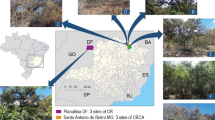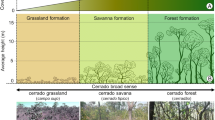Abstract
Brazil is the largest country in Latin America and one of the food producers world’s leading. Much of its territorial extension, about 35% is covered by a type of vegetation classified as savannahs. The Cerrado and the Caatinga, two biomes with distinct phytophysiognomies, make up the Central American Savannahs, which are characterized by low vegetation and small tree species. Central American Savannahs are environments that naturally offer adverse abiotic conditions for plant growth and development. With low levels of phosphorus and a limited water regime, plants depend directly on the performance of mycorrhizal fungi to resist and survive such conditions, attributing to the association between fungi and plants an important role in the resilience to stressful situations.
Access this chapter
Tax calculation will be finalised at checkout
Purchases are for personal use only
Similar content being viewed by others
References
Bâ, A. M., Duponnois, R., Moyersoen, B., & Diédhiou, A. G. (2012). Ectomycorrhizal symbiosis of tropical African trees. Mycorrhiza, 22(1), 1–29.
Bertolazi AA, Canton GC, Azevedo IG, Cruz ZMA, Soares DNES, Conceição JM, Santos WO, Ramos AC (2010) O papel das ectomicorrizas na biorremediação dos metais pesados no solo. Nat on-line 8:24–31
Baseia IG, Galvão TC de O (2002) Some interesting Gasteromycetes (Basidiomycota) in dry areas from northeastern Brazil. Acta Bot Brasil 16:1–8
Baseia IG, Milanez AI (2000) First record of Scleroderma polyrhizum Pers. (Gasteromycetes) from Brazil. Acta Bot Brasil 14(2):181–184
Beuchle R, Grecchi RC, Shimabukuro YE, Seliger R, Eva HD, Sano E, Achard F (2015) Land cover changes in the Brazilian Cerrado and Caatinga biomes from 1990 to 2010 based on a systematic remote sensing sampling approach. Appl Geogr 58:116–127
Bever JD, Morton JB, Antonovics J, Schultz PA (1996) Host-Dependent Sporulation and Species Diversity of Arbuscular Mycorrhizal Fungi in a Mown Grassland. Br Ecol Soc 84:71–82
Błaszkowski J, Kozłowska A, Niezgoda P, Goto BT, Dalpé Y (2018) A new genus, Oehlia with Oehlia diaphana comb. nov. and an emended description of Rhizoglomus vesiculiferum comb. nov. in the Glomeromycotina. Nova Hedwigia 107:501–518
Braz SP, Urquiaga S, Alves B, Boddey RM (2004) Degradação de pastagens, matéria orgânica do solo e a recuperação do potencial produtivo em sistemas de baixo input tecnológico na região dos cerrados. Seropédica, Embrapa
Casagrande LIT (1985) Micorriza em plantas de Cerrado: Duquetia furfuraceae (St. Hil.) & Hook. Rev Agric (Brazil) 60(2):107–110
Casagrande LIT (1986) Um caso de micorriza ectendotrófica em planta de Cerrado. Rev Agric (Brazil) 61:27–33
Casagrande LIT (1987) Ectomicorrizas e endomicorrizas em Jacaranda decurrens Cham. Rev Agric (Brazil) 62:229–237
de Pontes JS de, Sánchez-Castro I, Palenzuela J, Maia LC, Silva GA da, Oehl F (2013) Scutellospora alterata, a new gigasporalean species from the semi-arid Caatinga biome in Northeastern Brazil. Mycotaxon 125:169–181
de Pontes JS de, Santos VM, Pereira CD, Alves da Silva G, Maia LC, Oehl F (2017) Acaulospora spinulifera, a new arbuscular mycorrhizal fungal species from the Brazilian Cerrado and Atlantic Rain forest. Nova Hedwigia 105:219–229
Ferreira AJ, Wartchow F, Cortez VG (2013) Limacella ochraceolutea (Agaricomycetes) in the Atlantic forest of southern Brazil. Field Mycol 14:64–67
Filho MT, Krugner TL (1980) Formação de ectomicorrizas e crescimento de mudas de Pinus caribaea var. bahamensis em solo de viveiro infestado artificialmente com Thelephora terrestris e Pisolithus tinctorius no Litoral Sul da Bahia. IEPF 21:21–37
Giachini AJ, Oliveira VL, Castellano MA, Trappe JM (2000) Ectomycorrhizal fungi in Eucalyptus and Pinus plantations in Southern Brazil. Mycologia 92:1166–1177
Goto BT, Moreira M, Tsai SM, Cardoso EJBN, Maia LC (2008) Notas sobre Acaulospora bireticulata Rothwell &Trappe e primeiro registro de Acaulospora koskei Blask. para o Brasil. Acta Bot Brasilica 22:583–587
Howeler RH, Sieverding E, Saif S (1987) Practical aspects of mycorrhizal technology in some tropical crops and pastures. Plant Soil Interfaces Interact. Dordrecht, Springer Netherlands, p 249–283
Hunke P, Mueller EN, Schröder B, Zeilhofer P (2015) The Brazilian Cerrado: assessment of water and soil degradation in catchments under intensive agricultural use. Ecohydrology 8:1154–1180
Klink CA, Machado RB (2005) A conservação do Cerrado brasileiro. Megadiversidade 1(1):147–155
Lima ALA, Rodal MJN (2010) Phenology and wood density of plants growing in the semi-arid region of Northeastern Brazil. J Arid Environ 74:1363–1373
Mello CMA de, Silva IR da, de Pontes JS de, Goto BT, Silva GA da, Maia LC (2012) Diversidade de fungos micorrízicos arbusculares em área de Caatinga, PE, Brasil. Acta Bot Brasilica 26:938–943
Miranda JCC de (1986) Utilização das Micorrizas na Agricultura. Brasilia, Brazil
Miranda JCC de (2008) Cerrado: Micorriza arbuscular: ocorrência e manejo. Planaltina, Embrapa Cerrados, p 169
Miranda JCC de, Miranda LN de (2011) Contribuição da micorriza arbuscular para a produtividade e sustentabilidade nos sistemas de produção com plantio direto e convencional no Cerrado. Planaltina, DF: Embrapa Cerrados
Moreira FMS, Siqueira JO, Brussaard L (2006) Soil biodiversity in Amazonian and other Brazilian ecosystems. CABI 2006. Micorrizas. In: Moreira FMS, Siqueira JO (org) Microbiol e Bioquim do Solo. 2nd edition, p 729
Moura JB de (2015) Diversidade e colonização micorrízica em diferentes usos do solo no Cerrado. UNB
Moura JB de, Valentim NM, Ventura MVA, Junior WGV (2017) Taxa de colonização micorrízica sob diferentes sistemas de cultivo no cerrado em cana-de-açúcar. Faculdade de Tecnologia e Ciencias 2:60–66
Oehl F, Sieverding E (2004) Pacispora, a new vesicular arbuscular mycorrhizal fungal genus in the Glomeromycetes. J Appl Bot 78:72–82
Oehl F, Sieverding E, Mäder P, Dubois D, Ineichen K, Boller T, Wiemken A (2004) Impact of long-term conventional and organic farming on the diversity of arbuscular mycorrhizal fungi. Oecologia 138:574–583
Oliveira VL, Giachini AJ (1999) Ecologia e Aplicação de Ectomicorrizas. In: Siqueira OJ, Moreira FMS, Lopes AS, Guilherme LRG, Faquim V, Furtini Neto AE, Carvalho JG (eds) Inter-relação Fertil Biol do Solo e Nutr Plantas. Lavras, UFLA, p 818
Pagano MC, Scotti MR (2008) Arbuscular and ectomycorrhizal colonization of two Eucalyptus species in semiarid Brazil. Mycoscience 49(6):379–384
Porcel R, Ruiz-Lozano JM (2004) Arbuscular mycorrhizal influence on leaf water potential, solute accumulation, and oxidative stress in soybean plants subjected to drought stress. J Exp Bot 55:1743–1750
Santos HG dos, Jacomine PKT, Anjos LHC dos, Oliveira VÁ de, Lumbreras JF, Coelho MR, Almeida JA de, Cunha TJ (2013) Sistema brasileiro de classificação de solos. Embrapa, Brasilia, Brazil
Santos W de S, Henriques IGN, Santos W de S, Ramos GG, Vasconcelos G dos S, Vasconcelo ADM (2017) Análise florística-fitossociológica e potencial madeireiro em área de Caatinga submetida a manejo florestal. Agropecuária Científica no Semiárido 13:203–211
Silva DKA da, Freitas N de O, Cuenca G, Maia LC, Oehl F (2008) Scutellospora pernambucana, a new fungal species in the Glomeromycetes with a diagnostic germination orb. Mycotaxon 106:361–370
Singer R, Araujo I de J da S (1979) Litter decomposition and ectomycorrhiza in Amazonian forests. Acta Amaz 9:25–42
Souza BR, Moura JB, Oliveira TC, Ramos MLG, Lopes Filho LC (2016) Arbuscular Mycorrhizal fungi as indicative of soil quality in conservation systems in the region of vale do São Patrício, Goiás. Int J Curr Res IN 8:43307–43311
Spatafora JW, Chang Y, Benny GL, Lazarus K, Smith ME, Berbee ML, Bonito G, Corradi N, Grigoriev I, Gryganskyi A, James TY, O’Donnell K, Roberson RW, Taylor TN, Uehling J, Vilgalys R, White MM, Stajich JE (2016) A phylum-level phylogenetic classification of zygomycete fungi based on genome-scale data. Mycologia 108:1028–1046
Symanczik S, Al-Yahya’ei MN, Kozłowska A, Ryszka P, Błaszkowski J (2018) A new genus, Desertispora, and a new species, Diversispora sabulosa, in the family Diversisporaceae (order Diversisporales, subphylum Glomeromycotina). Mycol Prog 17:437–449
Taber A, Navarro G, Arribas MA (1997) A new park in the Bolivian Gran Chaco – an advance in tropical dry forest conservation and community-based management. Oryx 31:189–198
Thomazini LI (1974) Mycorrhiza in plants of the ‘Cerrado’. Plant Soil 41:707–711
Treseder KK, Cross A (2006) Global Distributions of Arbuscular Mycorrhizal Fungi. Ecosystems 9:305–316
Vasconcelos ADM, Henriques IGN, Souza MP de, Santos W de S, Santos W de S, Ramos GG (2017) Caracterização florística e fitossociológica em área de Caatinga para fins de manejo florestal no município de São Francisco-PI. Agropecuária Científica no Semiárido 13:329–337
Veloso HP, Rangel Filho ALR, Lima JCA (1991) Classificação da Vegetação Brasileira Adaptada a um Sistema Universal. CDDI, organizador. Rio Janeiro, IBGE, Dep. Recur. Nat. e Estud. Ambient. Rio de Janeiro: fundação instituto brasileiro de geografia e estatistica
Vieira FA (2001) Micorrizas na Região do Cerrado. Universidade de Brasilia, Brazil, p 28
Author information
Authors and Affiliations
Editor information
Editors and Affiliations
Rights and permissions
Copyright information
© 2019 Springer Nature Switzerland AG
About this chapter
Cite this chapter
Moura, J.B., Cabral, J.S.R. (2019). Mycorrhizas in Central Savannahs: Cerrado and Caatinga . In: Pagano, M., Lugo, M. (eds) Mycorrhizal Fungi in South America. Fungal Biology. Springer, Cham. https://doi.org/10.1007/978-3-030-15228-4_10
Download citation
DOI: https://doi.org/10.1007/978-3-030-15228-4_10
Published:
Publisher Name: Springer, Cham
Print ISBN: 978-3-030-15227-7
Online ISBN: 978-3-030-15228-4
eBook Packages: Biomedical and Life SciencesBiomedical and Life Sciences (R0)




